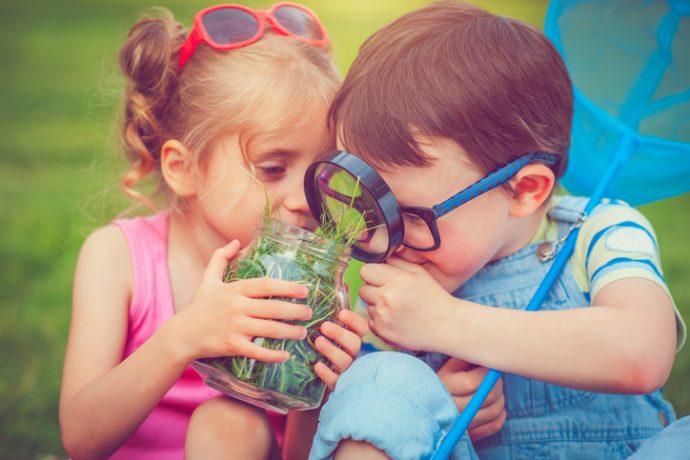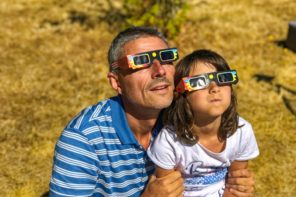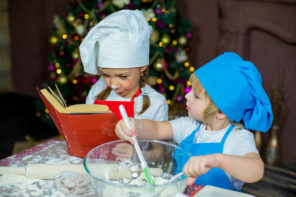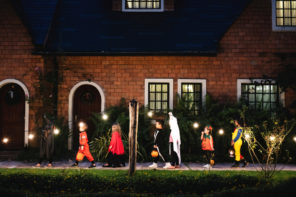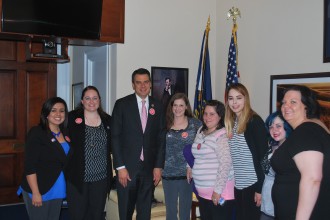It’s easy to be a scientist. Simply look around and ask “why?” We’re sure your children do that often enough! They’re well on their way to being scientists themselves. Try one of these fun, easy experiments to encourage you child’s interest in STEM, and hopefully answer at least one of those “whys.”
Experiment 1 – STICKY ICKY
Materials
- White school glue
- Food coloring
- Borax (found in the laundry aisle at store)
- Two pitchers (one labeled Borax solution; one labeled Water Only)
- Two pints of warm tap water Three tablespoons (one to measure plain water, one to measure glue, one to measure Borax)
- One teaspoon (to measure Borax solution)
- Two six-ounce plastic cups (one for plain water and glue mixture and one for Borax solution)
- One Popsicle stick (to stir Borax solution into plain water and glue mixture)
- Safety glasses
Procedure
- Put on the safety glasses.
- Take the pitcher of warm water labeled “Borax Solution.” Add one pint of warm water and two tablespoons of Borax and stir well.
- In one plastic cup, mix one tablespoon of plain warm tap water with one tablespoon of white glue. Stir well with Popsicle stick.
- Add a few drops of food coloring to the glue and water mix. Stir well with Popsicle stick.
- In another plastic cup, measure out two teaspoons of Borax solution.
- While stirring vigorously with Popsicle stick, slowly pour the Borax solution into the glue and water mixture. Keep stirring until there is no water/liquid left.
What This Means
The glue and water mixture contains molecular chains called “polymers” which move relatively freely as a liquid. When the Borax solution is added, it acts as a “cross-linker,” binding the polymer chains together and restricting their movement. It is this molecule in the Borax solution that causes the liquid to turn into “sticky icky.”
Experiment 2 – MARTIAN JELLY
Materials
- 1 tablespoon Grape Jelly
- 1/8 teaspoon Baking Soda (not baking powder)
- 1 tablespoon Vinegar
- 1/2 plastic cup of Warm Water
- Popsicle stick to stir solution FAMILY
Procedure
- Dissolve grape jelly in the glass of warm water and note the color.
- Add baking soda and stir. (Note: You should do this over a sink. A fizzing reaction will occur, possibly causing it to overflow.)
- Notice the change in color.
- Next, add vinegar and stir until the color of the grape jelly solution changes.
What This Means
Chemical reactions occur when one chemical comes into contact with another. For example, when you add baking soda (a base), it turns the solution basic and turns the purple color of the grape jelly solution to a greenish-black color.
Then, when you add vinegar (which contains acetic acid), the grape jelly solution re-acidifies and the color changes back to purple. Also, mixing baking soda and vinegar together causes a reaction that releases a gas called carbon dioxide.
Caution: This experiment requires parental supervision. Take care not to let any vinegar splash into your child’s eyes— it can sting.
Experiment 3 – MOLD MADNESS
Materials
- Three cups containing a little coffee or leftover food
- A magnifying glass
Procedure
- Put one cup with coffee or leftover food on a sunny windowsill, one in the refrigerator, and one in a dark cupboard.
- Look inside the cups every day for several days and write down what you see. Your magnifying glass will help. (It may take a few days for the mold to start growing.)
- Does temperature affect the mold’s growth? See if the cup on the windowsill grows mold more slowly, more quickly or at the same rate as the one in the refrigerator.
- Does light affect the growth of the mold? Does the cup on the windowsill grow mold at the same rate as the one in the dark cupboard?
- Look around your home for other molds. Inspect: pickles in a jar, cottage cheese, bread, paint on the walls, oranges, houseplants, tiles around a bathtub or shower.
- Are the molds all of the same color, or are they different?
What This Means
We can find molds in all sorts of unexpected places. Unlike green plants, they can’t make their own food from sunlight. Instead, they live directly off of what they are growing on.
Molds can be a nuisance when they settle on our food or possessions. But molds are also useful. The green spots on old oranges are penicillin mold. This is what the medicine is made from.
Bayer is a global enterprise with core competencies in the Life Science fields of healthcare and agriculture. Making Science Make Sense® (MSMS) is Bayer’s award-winning STEM education initiative that seeks to advance science literacy across the United States through hands-on, inquiry-based learning, employee volunteerism, community partnerships and public education.
Bayer and its MSMS partners are dedicated to changing the way science is taught and learned both in and out of the classroom. Bayer is a founding sponsor of National PTA’s STEM + Families initiative.

